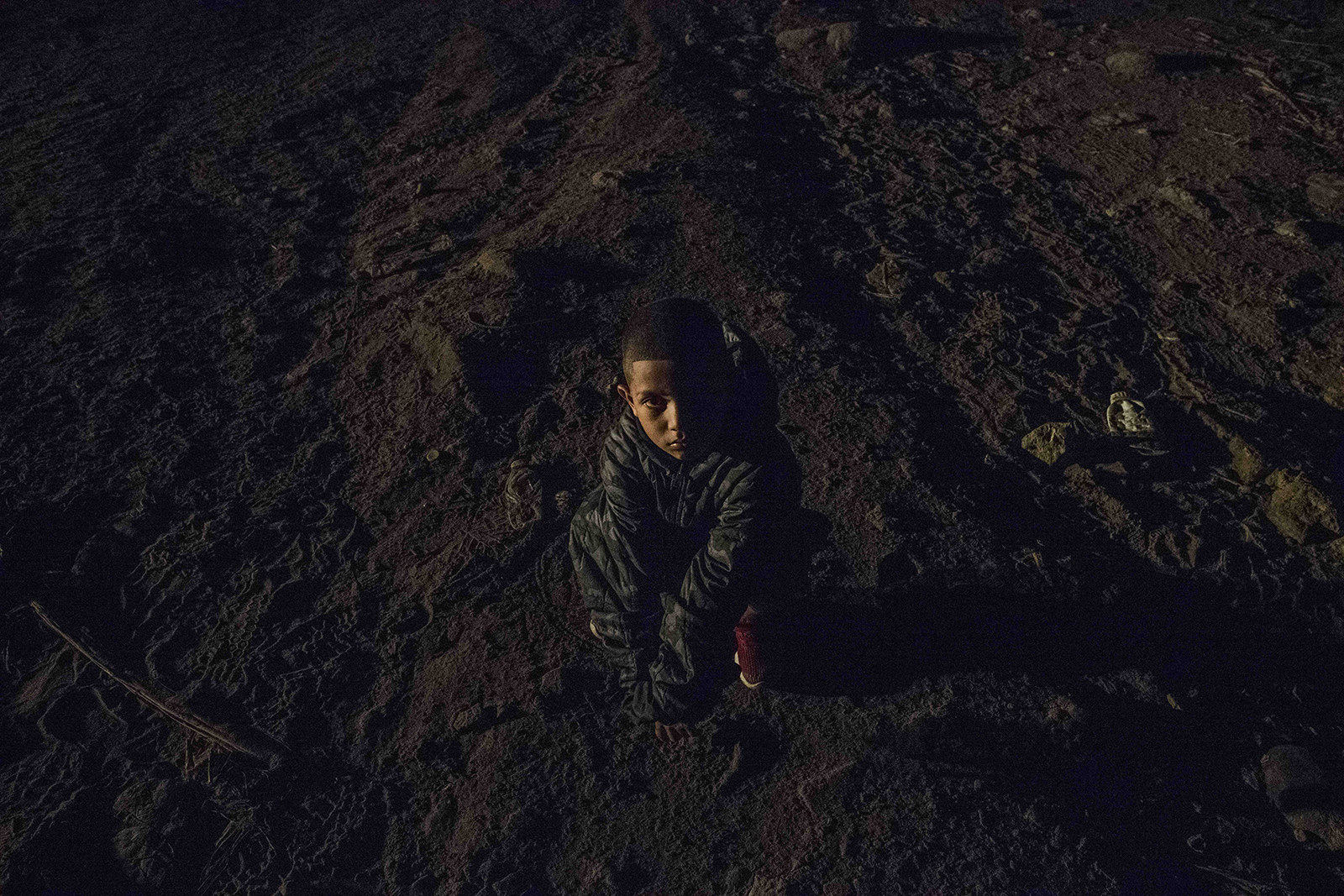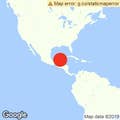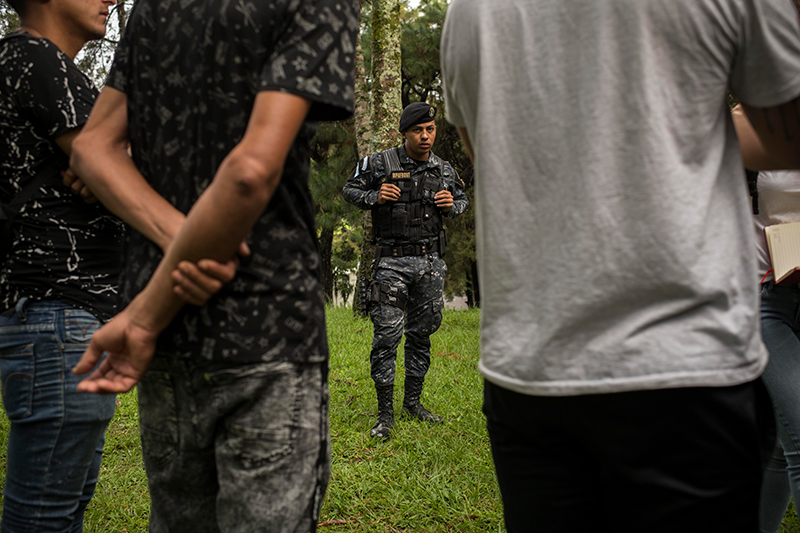AGUA CALIENTE, Guatemala — It all happened in under two minutes, shortly after the sun came up.
Brenda Rivera and her three children staggered out of the thick brush within view of the border post, walked up to a waiting van, piled in, and gripped the seat cushions as the driver revved the engine. They knew the journey ahead of them would be dangerous.
But they hadn’t made it far down the road when a police officer waved them down.
The driver of the van slammed on the brakes, coming to a halt in the middle of the road, and stepped out to talk to the officer. A look of panic swept across Rivera’s face. Her 10-year-old daughter wiped tears from her eyes while her two sons, 8 and 12, stared nervously out the window.
Rivera cursed under her breath. They had fled their home in northern Honduras in the middle of the night, entering Guatemala just before 8 a.m. through an illegal crossing, and already it looked like their journey might have come to an abrupt end.
“It’s all about money,” she muttered, looking through the windshield at the driver and officer, who were chatting like old friends. The cop would probably demand something from her, she thought, but Rivera wanted to keep as much cash with her as possible. “I’ll have to give him my phone.”
To Rivera’s surprise, the driver jumped back into the van and, without a word, started the engine again. It was a false alarm — this time.
Until recently, the hardest part of the journey to the United States started not in Central America — where there is free movement across borders and immigrants rarely draw attention — but in Mexico, where criminals often kidnap them and authorities extort or deport them. Now, under pressure from President Donald Trump, various administrations in the region are implementing anti-immigrant policies that have turned Guatemala into a minefield for people trying to cross the country.
Guatemalan police detain a group of immigrants from Congo and Haiti.
For all the talk of the US–Mexico wall, a version of it can now be found almost 3,000 miles south, in Central America — where the majority of immigrants coming through the southern border are from.
In recent months, the Trump administration has begun arm-twisting governments in Latin America into doing its own border work, much like the EU has done with Libya to deal with its immigrant crisis in the Mediterranean. Using a carrot-and-stick approach, the US has threatened the Mexican and Guatemalan governments with sanctions, while also offering Guatemala the promise of work visas for its citizens — and has at least partially succeeded in having them deter immigration through their territories.
In June, Mexico sent its National Guard to its southern border, forming an unprecedented wall with Central America. This summer, Guatemala launched “Operation Governance for Irregular Migration” to detain and deport undocumented immigrants. Shortly after that, the country’s interior minister signed a “safe third country” agreement with the US, under which Salvadoran and Honduran asylum-seekers who make it stateside will be bounced back to Guatemala, where they will be allowed to remain while they seek asylum there.
For all the talk of the US–Mexico border wall, a version of it can now be almost 3,000 miles south, in Central America.
These may be the tip of a growing iceberg, with deterrence policies likely to expand ever southward. Last week, acting US Secretary of the Department of Homeland Security Kevin McAleenan traveled to Panama to discuss with officials means of stopping irregular immigration. Shortly after, El Salvador announced that it would implement “border patrols” to combat illegal immigration. On Wednesday, McAleenan visited El Salvador, where he signed a letter of intent with President Nayib Bukele “intended to strengthen the region’s borders.”
For now, this pressure has been most effective in Guatemala, where the US found a pliable administration nearing the end of its term and willing to sign the agreement last month.
Already, the flow of immigrants has decreased slightly across the country since April. Part of the reason may be the natural dip observed during summer months, which tend to be followed by an increase in the fall. But some people who were planning on immigrating are staying put to see how these new policies will affect their chances of making it to the US. For others, growing anti-Latino sentiment in the US, terrifyingly evident from a shooting at a Walmart in El Paso this month where the suspect reportedly said he targeted Mexicans, has become a new part of the equation when making these decisions.
Still, many remain undeterred. Staying in Guatemala, El Salvador, or Honduras — where gangs run rampant and homicide rates are some of the highest in the world — is simply more dangerous.
For them, the journey north has become riskier and more expensive, as they are forced to take more obscure routes, travel at night, and pay off a growing cadre of corrupt law enforcement agents along the way. And as these immigrants grow more vulnerable to abuse or crime, they are less likely to seek help from the state.
BuzzFeed News traveled with Rivera and her family the length of Guatemala earlier this month, from the densely tropical border with Honduras, through checkpoints and other threats along the highways, across the dizzyingly humid border with Mexico, to see whether they would reach their destination amid these new immigration control measures — and at what cost.
“The government thought this would be easy, just sign on the dotted line,” said Father Mauro Verzeletti, who heads an immigrant shelter in Guatemala City, “but we know how complicated this will get.”
For Rivera, it was about to become clear.
Rivera and her children in various buses during their journey across Guatemala.
Rivera and her children spent the morning furtively switching from bus to bus across southern Guatemala.
There was the freezing cold bus in which the Liam Neeson film Taken was playing for passengers, the one with the broken window where rain poured in and soaked Rivera’s daughter, yet another one that was already a blur. When there were bathrooms, they were kept under lock and key by the drivers. For those who mustered up the courage to ask to use them, the instruction was clear: “Only peeing allowed.”
After more than four hours through winding roads and past countless evangelical churches, they made it to one of the main bus terminals in Guatemala City — about a third of the way to the border with Mexico. Rivera held tightly to her children’s wrists as they descended from one bus, ran past shoulder-height tires, zigzagged around clusters of suitcases, and climbed into another. By then, they were hundreds of miles from home, where Rivera’s 12-year-old son had recently gotten a threat from a local gang: Join us, or else.
It wasn’t far enough for Rivera to feel any relief yet.
Most immigrants who go through Guatemala must pass through the capital. It is here where flights from the US filled with Guatemalan deportees arrive almost daily. Guatemalan government officials expect the number to increase in the coming weeks, and especially when the safe third country agreement comes into effect, although no one seems to know when that will be.
Rivera had not heard about the recently signed agreement and rolled her eyes when it was explained to her. It’s preposterous, she said.
Shortly before Guatemalan Interior Minister Enrique Degenhart signed the deal with McAleenan in Washington, DC, last month, Trump warned of sanctions: “Tariffs, Remittance Fees, or all of the above,” he tweeted, a threat that stoked fears in a country where more than 10% of gross domestic product comes from money sent home by citizens living abroad. The US has offered to triple the number of temporary farmworker visas for Guatemalans in an effort to garner support from the conservative President-elect Alejandro Giammattei, who earlier this month won a general election marked by low turnout.
The Trump administration’s growing web of anti-immigrant policies has shuttered many of the previously available avenues into the US and has forced many who want to enter the country in search of work to become asylum-seekers. By doing so, those who truly need asylum are diluted in this growing network of immigrants, many of whom are now at risk of being sent to Guatemala.
The idea that Guatemala could handle an influx of immigrants is dubious at best. The country is wildly corrupt and has seen many members of its elite, including a former president, judges, and business leaders, arrested and charged with graft. The widely lauded UN-backed International Commission Against Impunity in Guatemala is winding down its work after the current president failed to renew its mandate. This leaves the country vulnerable to yet more corruption just as it is expected to receive new immigrants. And it’s not only corruption they will face — the US even warns against travel to Guatemala because of the high levels of violent crime.
After his electoral win, Giammattei said that the agreement with the US was unsustainable as it stands, given the country’s current condition, and noted that there are elements of the deal he doesn’t even know about.
Under the deal, asylum-seekers bounced from the US back to Guatemala will be able to file a claim at the asylum-processing office in the capital — which has just eight employees and is already overworked. Until last month, none of the 288 requests pending this year had been accepted yet.
Eighty-two percent of Guatemalans reject the agreement, according to a poll by Prensa Libre, a national newspaper. Even some within the Trump administration appear to have opposed it: Secretary of State Mike Pompeo reportedly expressed concern that Guatemala is unable to protect asylum-seekers fleeing neighboring countries. Kimberly Breier, assistant secretary of state for Western Hemisphere Affairs, resigned this month after being chastised for not publicly defending the agreement, according to the Washington Post.
“The negotiation was obscure and done under the table,” Guatemala’s human rights ombudsperson, Jordán Rodas, told BuzzFeed News. As he sat down for an interview in his office, he took out a stress ball and squeezed it in his fist a few times before setting it down on the table.
After Mexico rejected the US’s demand to become a safe third country, the Trump administration looked to Guatemala and found a “very weak, docile, and subservient government,” said Rodas.
Rodas said his office’s budget for this year had been slashed by about 20%. Rodas, whose family has had to leave the country twice following death threats, is fighting the agreement at the country’s Constitutional Court, on the grounds that it was signed under threat and by a minister, rather than the president. If the court rejects his appeal, Rodas says he will attempt to fight it in international courts.
“If the deal were to be implemented, Guatemala would collapse,” said Rodas, noting that the country cannot even provide for its own citizens. Guatemala has the sixth-highest rate of chronic malnutrition in the world, according to the United States Agency for International Development.
To take in more asylum-seekers than Guatemala currently has, a significant investment would be necessary to strengthen everything from shelter arrangements to building schools, according to Giovanni Bassu, regional representative for Central America for the United Nations High Commissioner for Refugees. And it would take time, said Bassu.
As the bus Rivera and the children were traveling in made their way through the narrow streets of downtown Guatemala City, they hit rush hour and slowed to a crawl. Rivera, whose forehead appeared permanently scrunched up with worry, turned to chat with the woman behind her. They discovered they were both headed to the border.
Rivera looked around and lowered her voice. You are traveling alone, and I have my kids with me, she told the woman. It was a simple equation in her mind: They should travel together.
“It’s safer,” Rivera told the stranger, in an effort to convince her.
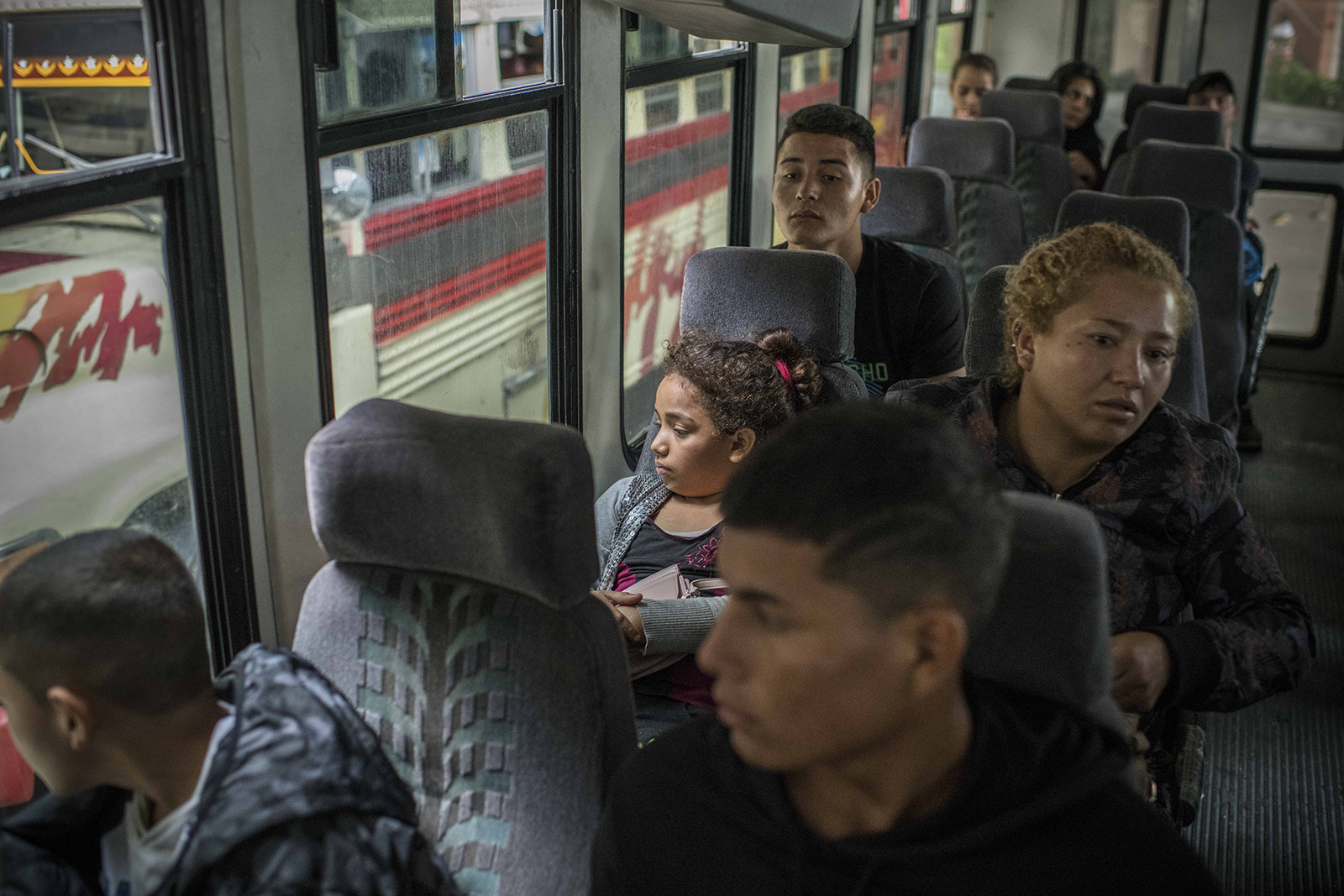
It was broad daylight but the bus suddenly turned dark.
“Close the curtains!” the bus driver’s assistant, Gerardo Ramírez, ordered the passengers as he walked down the aisle. “Until we leave the city, we’ll be surrounded by lizards, by police. They’ll pull you out of here one by one.”
Rivera and her children were in their fourth and final bus of the day. If all went to plan, this one would deliver them to the Guatemala–Mexico border by 10 p.m.
On his way back down the aisle, Ramírez, 24, announced that everyone would have to hand over the document showing they had legally entered Guatemala. Rivera, who had been sharing a bottle of soda with one of her sons, froze for an instant, got up, and took the seat behind Ramírez.
“What can we do? We don’t have papers,” Rivera told him, giving him a mistrustful look.
“We’re definitely going to get pulled over, and they’re pure business,” Ramírez responded while scrolling through a reggaeton playlist on his phone.
“We could drive around the checkpoint,” the driver chimed in, grinning.
Rivera understood right away. “How much will that cost me?”
“Until we leave the city, we’ll be surrounded by lizards, by police. They’ll pull you out of here one by one.”
A long pause. “It’ll take half an hour more, so whatever that is in gas money,” said Ramírez.
Rivera took a deep breath. “It’s all bisne, huh?” she responded, a look of controlled rage sweeping across her face. “We are all siblings here and they still throw shit at you,” she muttered.
Since Operation Governance was launched, traveling through Guatemala has become a game of chance — despite a 2006 agreement that allows for free movement across borders between Guatemala, Honduras, El Salvador, and Nicaragua. Now, people from these countries say Guatemalan authorities are denying them entry for not complying with requirements that were previously overlooked, such as having written authorization from both parents for minors (as in Rivera’s children’s case).
Hardly anyone used to get deported from Guatemala. But the new police operation has already more than tripled the amount of deportations of some Central Americans. Between January and July this year, Guatemala deported 349 Hondurans and 134 Salvadorans, up from 130 and 42, respectively, during 2018.
It’s not only Central Americans who are being rounded up: A growing number of immigrants from Haiti, Cuba, and several African countries have been trying to get through Guatemala on their way to the US. During the first half of this year, 241 Haitians, 115 Cubans, and 56 Cameroonians were deported. Previously these numbers were negligible. If Operation Governance works, they will steadily climb.
But while they are meant to deter immigrants, these new policies have created a revolving door at Guatemala’s borders. Most people who have been deported simply start their journey north again almost immediately after being dumped on the other side.
After all, life is often so much worse back home. “The circumstances they’re fleeing where they’re being targeted by gang members and government officials are worse,” US Rep. Norma Torres, a Democrat representing California, told BuzzFeed News. “Unlike here in the US, where you can dial 911 and get a paramedic. In their country, that is something they can’t do.”
If Rivera and her family got caught and sent back home, she said, they simply would try again. And again. But as the bus neared the Mexican border, Rivera pushed that possibility out of her mind.
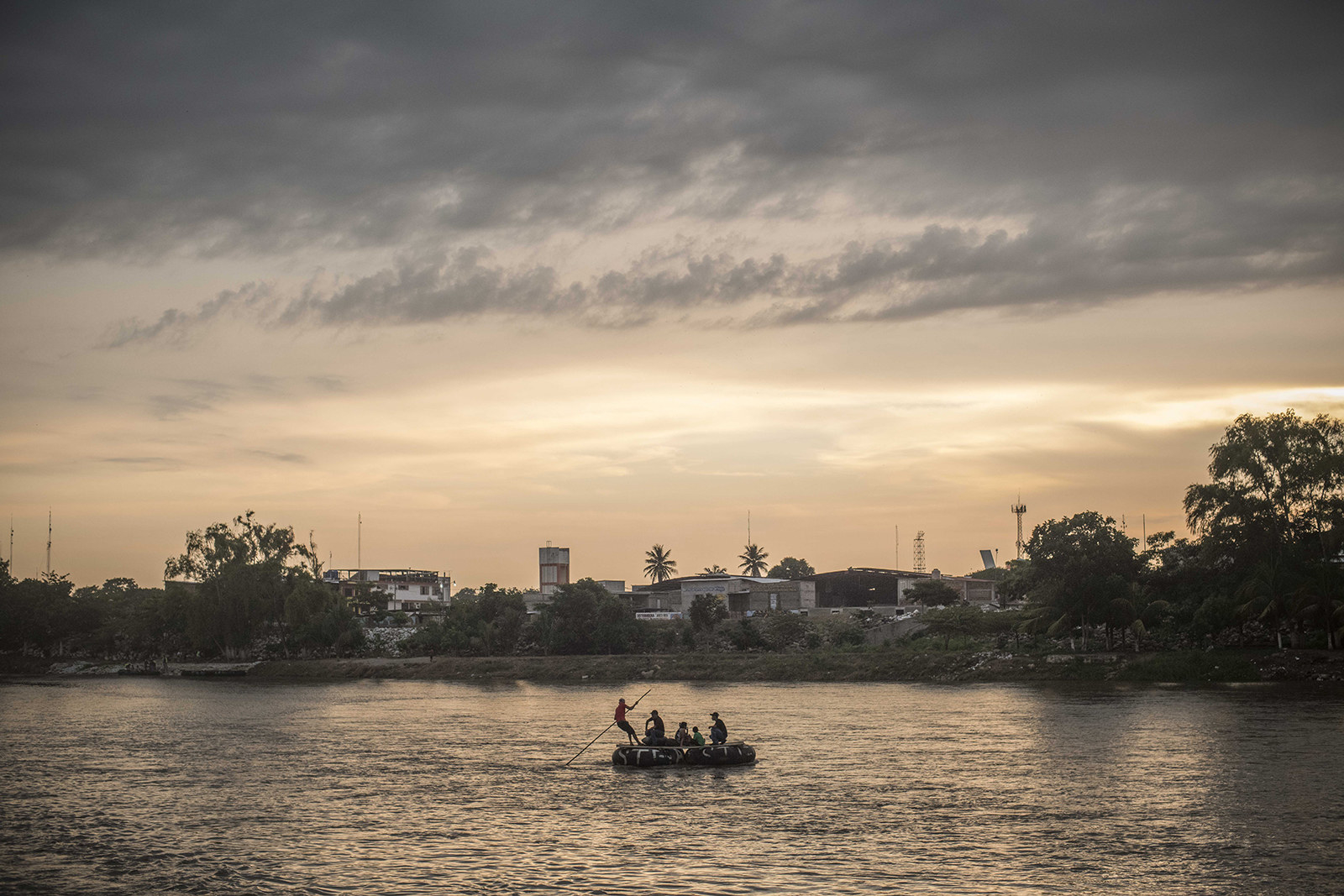
The passengers were momentarily blinded.
“Gentlemen, we have arrived,” Ramírez said as the bus lights came on. “The border.”
Rivera had spent the last hour debating with the other dozen or so immigrants in the bus whether to wait till the morning to cross the river into Mexico. She still hadn’t made up her mind when they arrived at the bus station at Tecún Umán, a town on the banks of the Suchiate River.
Outside, a few men loitered near the bus, the only light coming from a nearby convenience store. Rivera exchanged whispers with two other women in the group, her eyes darting between her children, who were crouching on the ground, exhausted.
They would cross tonight, she decided.
The group walked out of the terminal into the pitch-black night. Almost immediately, a handful of tricycle taxi drivers encircled them, warning Rivera and the others that the city was crawling with police and offering them rides to the river, about a mile away.
After some haggling, they agreed on a price. As the tricycles swerved around corners, the only noise in the city came from bars with posters of seminude women plastered on the doors. They snuck past the bridge that spans the Suchiate River, the legal crossing point between Guatemala and Mexico. Its chain-link fence was closed till the morning, the government offices dark.
The streets were empty that night, but residents say Tecún Umán has become safer since Mayor Erik Súñiga took office. Súñiga, who the Associated Press has reported is wanted by the US Drug Enforcement Administration on drug charges, is said to have installed cameras around town and set up a control room near the main plaza where officers monitor the livestreams.
“You have to change your attitude. It’s not going to get you anywhere.”
Rivera and the others got off the tricycles, paid the drivers, and walked down an alley toward the river, dodging puddles as they descended. They stopped just short of the water, where a smuggler stood near a collection of rafts made out of tires, one stacked against the other. Time for another negotiation.
“100 [quetzals] per person,” said the smuggler, his back to the river as he stared at the group.
The group huddled together and collected 400 quetzals, or about $52, in bills and coins, still short. There was a long stare down, the immigrants pleading. The smuggler crossed his arms — no. Rivera offered her cellphone to make up for the difference. He still wouldn’t agree to take them across.
“Just do it already. For the kids,” the smuggler told them, certain that some people in the group were withholding money. Rivera’s daughter looked like she was about to cry again. Fed up, Rivera gave the smuggler a dirty look.
“You have to change your attitude. It’s not going to get you anywhere,” the smuggler hissed at her.
“Stop right there. Don’t try to run.”
“Puta. All this for 200 quetzals more. Shit,” said Rivera.
She considered calling it off until the morning, but she didn’t want to spend another night in Guatemala looking over her shoulder for cops or criminals. And from where the group was standing, they could already see the other side of the river, less than 500 feet away. It would take under three minutes to cross it.
At last, the smuggler relented, took Rivera’s cellphone, and walked the group down to the waiting raft. A nearly full moon lit up their faces and for a moment, the only sound was the lapping of waves against the tires.
“Look at the beautiful moon tonight,” a woman whispered as the raft crossed the river’s halfway mark. Someone shushed her. The empty border bridge glinted about 100 yards to the right of the group.
They landed next to a clearing on the riverbank. Rivera and the children jumped off the raft and started walking up, hunching their backs low to the ground.
Suddenly, a voice pierced the darkness: “Stop right there. Don’t try to run.” Flashlights started sweeping across the group.
“This is the National Guard,” a voice thundered.
Rivera and her children prepare to depart by boat from Tecún Umán to Mexico.
The soldiers, wearing full camouflage gear, emerged from the darkness. Soon, their silhouettes were lit up by the headlights of an approaching military truck. The border guards inched their way closer to the group, forming a wide circle around them. Rivera watched the men carefully, her eyes stopping on one soldier’s assault rifle, slung tightly across his chest.
When the head of the unit asked for everyone’s IDs, the children started to cry and the women to plead: Let us go back to Guatemala. Instead, the soldiers called for reinforcements.
When the group learned they would be taken to a detention center and then deported, they gathered in a circle. They began to pray, their voices swirling with the sounds of crickets in the nearby bushes and cumbia blasting from across the river.
Rivera lit a cigarette. Then, a white van from the National Institute of Migration, its windows reinforced with security bars, arrived to take them away. ●
